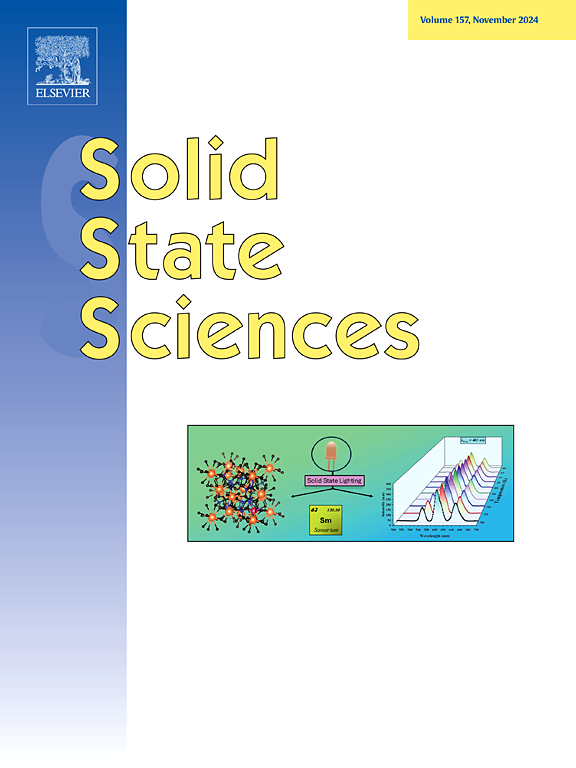Low-temperature aqueous synthesis of Cu2AgInSe4 quantum dots for application in quantum dots-sensitized solar cells
IF 3.3
3区 化学
Q2 CHEMISTRY, INORGANIC & NUCLEAR
引用次数: 0
Abstract
In this study, for the first time, the quaternary Cu2AgInSe4 (CAISe) quantum dots (QDs) were synthesized in an aqueous solution using the chemical precipitation method at 90 °C. It was observed that increasing the heating time led to a redshift in the absorption edge wavelength and a decrease in the band gap energy. The synthesized QDs, subjected to different heating durations ranging from 1 to 5 h, were employed as light absorbers in quantum dots sensitized solar cells (QDSSCs). The best performance was achieved for the QDSSC with a TiO2/CAISe(1 h)/ZnS photoanode, yielding a power conversion efficiency of 1.72 %. It is worth noting that in this study, a ZnS blocking layer was applied to all photoanodes. Subsequently, to enhance the power conversion efficiency, a CdS nanoparticles layer was deposited on the TiO2 mesoporous sublayer using a successive ionic layer adsorption and reaction (SILAR) method. Considering the alignment of the conduction and valence band edges of CdS and CAISe, the CdS layer is deposited first, followed by formation of the CAISe layer. For comparison, each QD was also deposited individually on TiO2 to evaluate its photovoltaic response. Then, different photoanode structures i.e., the TiO2/CdS(Xc)/CAISe/ZnS, (X = 1–8), photoanodes were fabricated and applied in corresponding QDSSCs. It was observed that the highest power conversion efficiency (PCE) of 4.0 % was achieved by the cell with the TiO2/CdS(7c)/CAISe/ZnS photoanode.

低温水法制备Cu2AgInSe4量子点用于量子点敏化太阳能电池
本研究首次在90°C的水溶液中采用化学沉淀法合成了四元Cu2AgInSe4 (CAISe)量子点(QDs)。观察到,加热时间的增加导致吸收边波长红移,带隙能量减小。将合成的量子点经过1 ~ 5 h的不同加热时间,作为光吸收剂应用于量子点敏化太阳能电池(QDSSCs)中。TiO2/CAISe(1 h)/ZnS光阳极的QDSSC性能最佳,功率转换效率为1.72%。值得注意的是,在本研究中,在所有光阳极上都应用了ZnS阻断层。随后,为了提高功率转换效率,采用连续离子层吸附反应(SILAR)方法在TiO2介孔亚层上沉积了CdS纳米颗粒层。考虑到CdS和CAISe的导价带边的排列,首先沉积CdS层,然后形成CAISe层。为了比较,每个量子点也单独沉积在TiO2上,以评估其光伏响应。然后,制备了不同结构的光阳极,即TiO2/CdS(Xc)/CAISe/ZnS (X = 1-8),并应用于相应的QDSSCs中。结果表明,采用TiO2/CdS(7c)/CAISe/ZnS光阳极的电池功率转换效率最高,达到4.0%。
本文章由计算机程序翻译,如有差异,请以英文原文为准。
求助全文
约1分钟内获得全文
求助全文
来源期刊

Solid State Sciences
化学-无机化学与核化学
CiteScore
6.60
自引率
2.90%
发文量
214
审稿时长
27 days
期刊介绍:
Solid State Sciences is the journal for researchers from the broad solid state chemistry and physics community. It publishes key articles on all aspects of solid state synthesis, structure-property relationships, theory and functionalities, in relation with experiments.
Key topics for stand-alone papers and special issues:
-Novel ways of synthesis, inorganic functional materials, including porous and glassy materials, hybrid organic-inorganic compounds and nanomaterials
-Physical properties, emphasizing but not limited to the electrical, magnetical and optical features
-Materials related to information technology and energy and environmental sciences.
The journal publishes feature articles from experts in the field upon invitation.
Solid State Sciences - your gateway to energy-related materials.
 求助内容:
求助内容: 应助结果提醒方式:
应助结果提醒方式:


